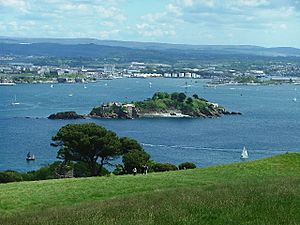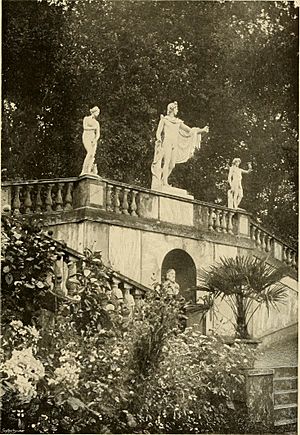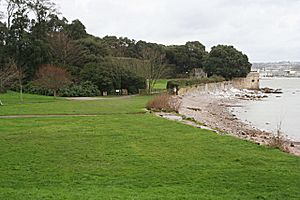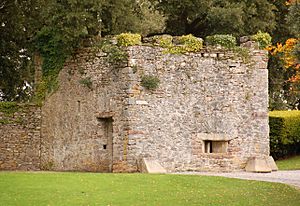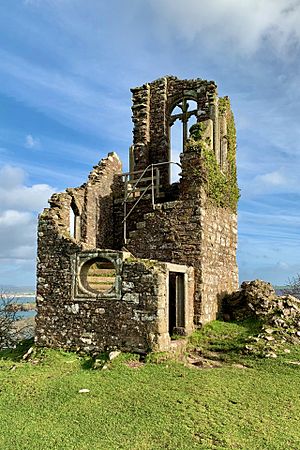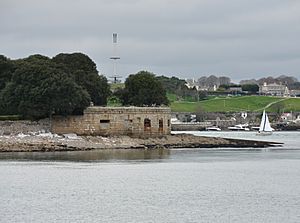Mount Edgcumbe Country Park facts for kids
Mount Edgcumbe Country Park is a really special place in Cornwall, England. It's one of only four official country parks in Cornwall and is known for its amazing history and beautiful nature. The park covers about 885 acres (3.58 km2) on the Rame Peninsula. From here, you can see fantastic views of Plymouth Sound and the River Tamar.
This park has been famous since the 1700s. Back then, the Edgcumbe family, who owned the land, created stunning gardens, interesting buildings called "follies" (which look like old ruins but were built for fun), and lovely woodlands around their old Tudor house. You can find unique trees, like giant redwood trees, and even spot wild fallow deer roaming freely. A long walking path called the South West Coast Path goes through the park for nine miles (14 km) right along the coast.
Inside the park, you'll also find the charming villages of Kingsand and Cawsand, plus the historic Mount Edgcumbe House itself. The most beautiful parts are the Formal Gardens, located near Cremyll. These gardens were first started in the 1600s but were redesigned by the Edgcumbe family in the 1700s. They include an Orangery (a special greenhouse for orange trees), an Italian Garden, a French Garden, an English Garden, and a Jubilee Garden, which opened in 2002 to celebrate the Queen's Golden Jubilee.
The park and its Formal Gardens are open every day of the year, and it's completely free to visit! Cornwall Council and Plymouth City Council work together to manage the park. While the Formal Gardens are carefully looked after, most of the park has a more natural, wild feel, which makes it great for exploring.
Exploring Mount Edgcumbe Park
Mount Edgcumbe Country Park is full of interesting historical spots and beautiful views. Many of these features are protected as important historic buildings.
- Barn Pool: This is a calm, deep bay. The Vikings used it as a safe place to anchor their ships way back in 997! There's also a shipwreck of a ship called the Catharina von Flensburg offshore. A very famous ship, HMS Beagle, set sail from here in 1831 on its second big journey. On board was the famous scientist Charles Darwin.
- Ancient Burial Mound: Around 1200 BC, people built a Bronze Age burial mound here. Later, in the 1700s, it was reused as a "Prospect Mound," a place where people could enjoy the views.
- Old Fort (Blockhouse): Built around 1545 during the time of King Henry VIII, this small fort on the shoreline helped protect the mouth of the River Tamar. It also guarded the Edgcumbe family's town of West Stonehouse across the water.
- Coastguard Station: Located at Rame Head, this building was first a Lloyd's Signal Station. Ships would use flags during the day and lights at night to send messages to the station. It became a radio station in 1905 and then a Coastguard station around 1925.
- Cremyll Ferry: This ferry has been an important way to cross between Devon and Cornwall since medieval times, starting around 1204.
- Deer: In 1515, King Henry VIII gave Sir Piers Edgcumbe permission to keep deer in the park. The deer you see today still roam freely across the Rame Peninsula.
- Deer Wall (Ha-Ha): Built around 1695, this is a stone wall with a hidden ditch. It was designed to protect the beautiful Amphitheatre area from the deer without blocking the view.
- Earl's Drive: This scenic driveway follows the coast. By 1788, it went from the house to Maker Church, and by 1823, it was extended all the way to Penlee Point.
- The Folly: Built in 1747, this artificial ruin replaced an old navigation tower. It was made using stones from old churches in Stonehouse.
- Formal Gardens: These beautiful gardens were created between 1750 and 1820, with styles inspired by Italian, English, and French designs. Newer gardens, like the New Zealand, American (1989), and Jubilee Gardens (2003), have been added more recently.
- Garden Battery: This area was an 18th-century platform with 21 guns used to fire salutes when important visitors arrived. It was rebuilt in 1863 as part of Plymouth's Naval defences, with strong granite walls for seven large guns.
- Harbour View Seat: This 18th-century ornamental seat, also called White Seat, offers great views north up the River Tamar.
- Ice House: Built around 1800, this underground building was used to store ice. It's located under the bridge leading to the main house and is only open on special occasions.
- St Mary's and St Julian's Church: First mentioned in 1186, this church was made bigger in the 1400s. It's the family church of the Edgcumbes.
- Milton's Temple: This round temple from 1755 has a special plaque with lines from the famous poem Paradise Lost.
- The Orangery: Located in the Italian Garden, this building was likely built around 1760. Today, it's a restaurant where you can enjoy a meal.
- Penlee Battery: These are the remains of a Victorian fort from 1892. It had three guns and was used in both World Wars.
- Queen Adelaide's Grotto: This 18th-century cave was used as a watch house. After Queen Adelaide visited in 1827, it was improved with an arched stone building.

- Rame Church: This church was rebuilt from a Norman church in 1239 and made larger in the 1400s.
- Stables: Built around 1850, these buildings included stables for horses, a dairy, a blacksmith's shop, a sawmill, and storage areas. Today, the stables are open to the public and have a cafe, activity centers, and art studios.
- St. Julian's Well: This is a very small 15th-century chapel and a holy well, which was restored around 1890.
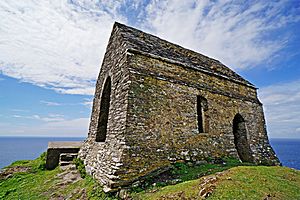
- St. Michael's Chapel: This chapel from the 1300s also served as a simple lighthouse with a beacon nearby. You can also see the remains of an Iron Age fort across the headland.
- South West Coast Path: This famous walking path goes right through the Country Park, offering amazing coastal views.
- Thomson's Seat: From around 1760, this beautiful pavilion has seats looking out over Plymouth Sound. It has verses from the poem The Seasons carved into its wall.
- West Lodge and Arch: The arch over the Earl's Drive might have been built to celebrate when the Viscount title was created in 1781.
- Zig-Zags: These winding paths were created in the 1760s and became famous in the 1800s as "The Horrors" because of their dramatic cliffside location and exotic plants. Some lower paths and stone seats have been lost due to cliff erosion.
Wildlife in the Park
Mount Edgcumbe Country Park is also home to interesting wildlife. For example, in August 2013, members of the Cornish branch of Butterfly Conservation discovered several caterpillars of a rare moth called the beautiful pearl (Agrotera nemoralis). They found them on European hornbeam trees (Carpinus betulus). Before this discovery, this tiny moth was only known to live in one other place in Britain, East Blean Woods in Kent.


